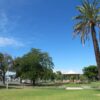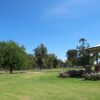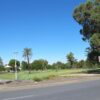Planning for parklands
In his 1837 Plan of Adelaide Surveyor-General Colonel William Light created a grid pattern of streets, bounded by terraces to the north, south, east and west and surrounded by park lands. This was a visionary plan for a city and reflected up-to-date views on the importance of fresh air and open space in urban areas. It is thought to be a unique design feature, recognised in 2008 by the inclusion of the Adelaide Parklands on the National Heritage List. In all the parklands comprised some 931ha (2300 acres) in 1837, although subsequent building reduced them to about 689ha (1702 acres).
Light was excited by the possibilities of the wide plain that stretched between the coast and the Mt Lofty Ranges and determined on this site for Adelaide in December 1836, despite its distance from the coast. The land Light saw in 1836 already resembled an ‘English park’ – a point which struck many early European settlers. Native grasses grew tall and thick, reaching to the horses’ manes in parts, while tall Eucalpyts dotted the landscape and fringed the River Torrens. Elsewhere grew Acacia (wattle), Sheoak and many flowering plants. Native birds and animals were in abundance. Animals included kangaroos, wallabies, possums, bilbies, native rats and many varieties of lizards and snakes – some 40 different species of mammals and 56 species of reptiles in all. Among the estimated 285 species of birds were parrots, lorikeets, magpies, kookaburras, black swans, several native duck species and many others. Birds survived the advent of Europeans better than mammals. It is thought that some 20 of the original 40 mammal species are now extinct, while about 7% of native birds are lost. The reptiles survived best of all.
The original inhabitants
Both plants and animals were important sources of food for the Kaurna people, whose lands included the site of Adelaide. They camped regularly along the banks of the Torrens, hunting, fishing and digging for the tubers and roots that were an important part of their diet. One important food was the yam daisy, which persisted on the parklands until the 1850s and 1860s, when sheep grazing took its toll.
Early European Occupation
The landscape Light and the early Europeans encountered was far from a ‘wilderness’, although that was the way they saw it. In fact, the Kaurna had managed their lands carefully for generations. They were especially skilled in the strategic use of fire to maintain open stretches of country for hunting and to control the thick undergrowth that might otherwise fuel wildfires. The new arrivals commented on this use of fire but they did not understand its importance in land management. Nor did they understand the need to tread lightly on the land, conserving food and plant resources. Within a decade they had denuded the parklands of trees, cut down for firewood, while livestock grazed on the grasses. The earliest photographs of Adelaide show the city surrounded by desolate paddocks, subject to ferocious duststorms in summer and muddy quagmires in winter. The parklands at this point were far from the landscaped ‘greenbelt’ we now admire.
The southern bank of the Torrens near the junction of North Terrace and West Terrace and the adjoining West Parklands were the sites of the earliest, makeshift, European settlement. Colonel Light pitched his tent in this area while he began his detailed survey of Adelaide from this northwest corner, while what was known rather grandly as ‘Emigration Square’ was sited on the parklands between Currie Street and North Terrace. Initially there were two rows of tents known as ‘Buffalo Row’ and ‘Coromandel Row’, named after two early ships, but other settlers simply camped where they pleased on the parklands, to the considerable displeasure of successive governors. In vain, Governor John Hindmarsh tried to evict campers from the parklands and to force them to take up land either in the city itself or in the country, but some could not afford to leave and they resisted strenuously. It was left to Hindmarsh’s successor, Governor George Gawler to evict these campers. It took him until early 1840 to do so. Emigration Square, a depot consisting of a series of semi-detached huts, survived on the West Parklands until 1849.
Development
Also located in the West Parklands was the city’s first burial ground. Light marked the location for a cemetery on his 1837 plan, opposite the area between Wright Street and South Terrace. Initially it was known simply as the Adelaide Public Cemetery, but was soon renamed West Terrace Cemetery. Many prominent South Australians are buried there and many fine memorials and new heritage trails are there. In 1843 the first of many separate burial areas was established for the Jewish community. Later allocations were made to the Catholic Church, Church of England and Society of Friends (Quakers), although there was much debate about these reserved areas from those who thought they were inconsistent with South Australia’s religious equality. West Terrace Cemetery was also the location for Australia’s first crematorium. Bishin Singh, a Sikh, was the first to be cremated there in May 1903. The crematorium was demolished in 1969.
A significant addition to the West Parklands was Adelaide High School in 1951. Originally Adelaide Boys High School, it became a co-educational school in 1977 when Adelaide Girls High School (originally the Advanced School for Girls) relocated from its Grote Street campus. Adelaide High School students have been selected on the basis of academic merit for much of its history.
Attempts to rehabilitate the parklands were made from the mid 1850s. Dismayed by the ‘unsightly’ parklands, newly arrived Governor MacDonnell provided funds to encourage tree planting in 1855 and some 11 000 seedlings were planted over the following year. Slowly the parklands began to improve. Especially significant were the beautification plans Conservator of Forests John Ednie Brown devised in 1880. These included the creation of recreation grounds and the Torrens Lake (1881), although separate areas were still fenced at this stage to contain many thousands of grazing stock, making access difficult for walkers or the newly enthusiastic cyclists. Many fenced areas bore signs on their gates that read ‘Cows Only’. The last cows were removed from the parklands in 1972. Those intent on recreation were also hampered by the absence of facilities: there were no lavatories in the parklands except near the City Bridge, until well into the 1950s.
Watering the parklands
One of the issues to divide city councillors and residents alike was the question of whether to water the parklands. For much of the 19th century watering was simply impractical, but later there was a strong body of opinion that thought the grassed areas should be allowed to brown naturally, rather than attempt to mimic European parks. Rather less attractive was the practice, continued until about 1960, of burning, rather than mowing the grass. The entire question of watering was resolved in 2010 when an irrigation system, using recycled water from the Glenelg Wastewater Treatment Plant opened, making it possible, finally, to surround Adelaide with swathes of green.








Comments